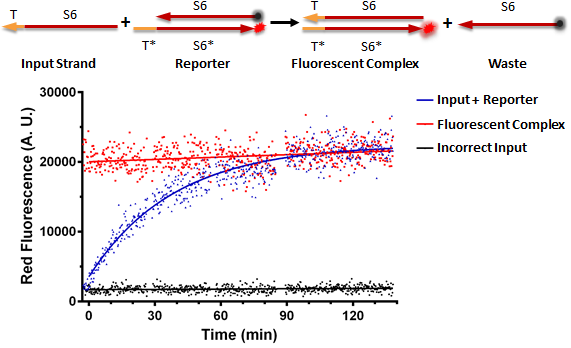Team:MIT/Results
From 2012.igem.org
RNA Strand Displacement In Vitro
In 2011, Lulu Qian and Erik Winfree of Caltech, published a paper "Scaling Up Digital Circuit Computation with DNA Strand Displacement cascades. Before our team attempted to bring the mechanism of strand displacement into an inv vivo context, we first decided to try assaying strand displacement in vitro using RNA. We used 2'-O-Methyl RNA strands that have never been proved before to strand displace in vitro. Before creating our own constructs, we decided to use sequences from Qian/Winfree and adapt them to RNA. Figure A shows a foundational experiment with RNA strand displacement in vitro, performed on a plate reader. The negative control, in black, is a well that receives just an anneal reporter complex. This reporter has gate strand T*S6* that is tagged with a fluorophore, 3' ROX. The top strand of the complex, the output strand, S6 which is complementary to S6*, is tagged with a quencher, that absorbs fluorescence from the fluorophore. When the two strands of the reporter are annealed, no fluorescence should be observed. The positive control, in red, is the input strand, TS6, annealed to the gate strand, T*S6* tagged with ROX. This is what we would expect the product of a strand displacement reaction to behave like. We can see that in the experimental well when the input is present, it can bind to the exposed T* domain of the reporter and displace the output, S6-quencher, strand yielding a fluorescent complex and waste.
Figure A
In 2011, Lulu Qian and Erik Winfree of Caltech, published a paper "Scaling Up Digital Circuit Computation with DNA Strand Displacement cascades. Before our team attempted to bring the mechanism of strand displacement into an inv vivo context, we first decided to try assaying strand displacement in vitro using RNA. We used 2'-O-Methyl RNA strands that have never been proved before to strand displace in vitro. Before creating our own constructs, we decided to use sequences from Qian/Winfree and adapt them to RNA. Figure A shows a foundational experiment with RNA strand displacement in vitro, performed on a plate reader. The negative control, in black, is a well that receives just an anneal reporter complex. This reporter has gate strand T*S6* that is tagged with a fluorophore, 3' ROX. The top strand of the complex, the output strand, S6 which is complementary to S6*, is tagged with a quencher, that absorbs fluorescence from the fluorophore. When the two strands of the reporter are annealed, no fluorescence should be observed. The positive control, in red, is the input strand, TS6, annealed to the gate strand, T*S6* tagged with ROX. This is what we would expect the product of a strand displacement reaction to behave like. We can see that in the experimental well when the input is present, it can bind to the exposed T* domain of the reporter and displace the output, S6-quencher, strand yielding a fluorescent complex and waste.
Figure A

Nucleic Acid Delivery
Delivery of Plasmid DNA to Mammalian Cells
Constitutive Expression of fluorescent markers etc
Delivery of 2'-O-Me RNA to Mammalian Cells
Movie of HEK293 cell being transfected with T*-S6*-ROX, as well as static images
15,20,25,30 pmol ratio data from FACS
Inducible Control of Protein Expression
DOX curve
Delivery of Plasmid DNA which transcribes short RNA Inputs
FF1 Knockdown Data
Delivery of Plasmid DNA to Mammalian Cells
Constitutive Expression of fluorescent markers etc
Delivery of 2'-O-Me RNA to Mammalian Cells
Movie of HEK293 cell being transfected with T*-S6*-ROX, as well as static images
15,20,25,30 pmol ratio data from FACS
Inducible Control of Protein Expression
DOX curve
Delivery of Plasmid DNA which transcribes short RNA Inputs
FF1 Knockdown Data
In Vivo RNA Strand Displacement
Strategy 1: Lipofectamine 2000 Transfection of RNA version of Reporter from Winfree/QIan 2011 Paper
Images will go here from April 24th experiment - display red fluorescence in all wells, including those that only got reporter or the wrong input - also see red vesicles indicating reporter comes apart inside the vesicles
Strategy 2: Switch Transfection reagent to RNAiMAX
RNAiMAX is supposed to be a better transfection reagent for double stranded RNA
Images will go here from experiment from June 13th onward where we do not see red vesicles, however we still see whole cell red fluorescence
Strategy 3: Tag RNA strand with an Alexa Fluorophore to act as a transfection marker
Strategy 4: Create DNA plasmids driving transcription of RNA inputs, while transfecting RNA Reporter
Strategy 4: Nucleofect RNA reporter, RNA inputs
[Strategy 5]: Redesign RNA Reporter
Strategy 1: Lipofectamine 2000 Transfection of RNA version of Reporter from Winfree/QIan 2011 Paper
Images will go here from April 24th experiment - display red fluorescence in all wells, including those that only got reporter or the wrong input - also see red vesicles indicating reporter comes apart inside the vesicles
Strategy 2: Switch Transfection reagent to RNAiMAX
RNAiMAX is supposed to be a better transfection reagent for double stranded RNA
Images will go here from experiment from June 13th onward where we do not see red vesicles, however we still see whole cell red fluorescence
Strategy 3: Tag RNA strand with an Alexa Fluorophore to act as a transfection marker
Strategy 4: Create DNA plasmids driving transcription of RNA inputs, while transfecting RNA Reporter
Strategy 4: Nucleofect RNA reporter, RNA inputs
[Strategy 5]: Redesign RNA Reporter
 "
"

